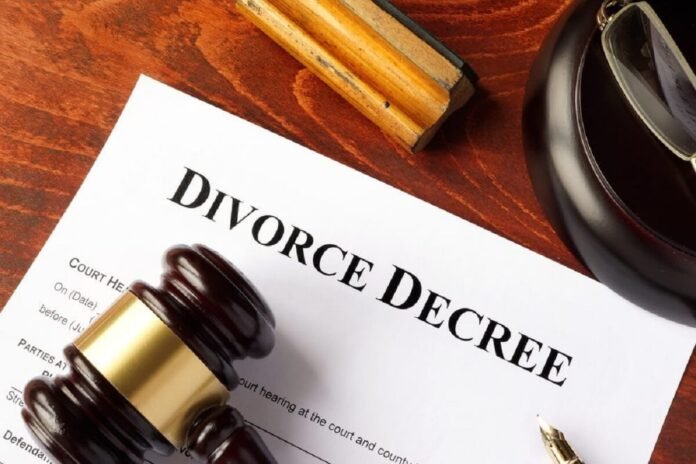Your divorce decree is an official court order outlining the terms established during your case regarding custody and visitation, child support, spousal support, and property division. It also includes a court-ordered name change (if applicable).
The specifics of your decree depend on what you and your spouse agreed upon outside of court. But most contain standard sections such as:
What is a Decree?
A divorce decree is the judge’s final ruling on all issues in your case – including property division, custody, and support. It’s typically several pages long and contains detailed information about each topic. Generally, a divorce decree incorporates the terms of your marital settlement agreement, though this is not always required. If you and your spouse reach an agreement outside of court on all issues in your case, your divorce may be uncontested, and you can prepare a final Decree yourself without going to a trial or hearing.
Your marriage is officially dissolved once the judge signs a final divorce decree. The judge’s signature also makes the order binding, meaning that your ex-spouse must legally follow its terms. You can go back to court to enforce the decree’s words if they don’t.
A final divorce decree usually includes basic information about the case, such as the court’s case number, the name of the court, and the date that your marriage was dissolved. It also includes the name of each spouse and any children from your wedding. Most courts keep copies of divorce decrees in their vital records office, and you can typically obtain a copy for a small fee (which is often the same amount as the filing fee for your original case). A final decree will also contain a court order that outlines any financial obligations or responsibilities your spouse may have, such as child or spousal support payments.
What is a Settlement Agreement?
A settlement agreement is an agreement between the parties in a divorce case on settling issues like property division, child custody, and support. During negotiations, often, the help of a non-biased mediator is needed to ensure that each party’s terms are met. Once the terms are agreed upon, they will be written into a “stipulation of settlement” or “marital settlement agreement.” This agreement will later become your final divorce decree, which outlines how your marriage ended and the details of any responsibilities you may have to fulfill going forward.
The level of detail that goes into a settlement agreement can vary, depending on the individual circumstances of each case. The final divorce decree will typically include the names of each spouse, a statement of the terms of the agreement and how it was reached, a signature from both parties, and a declaration that the marriage has been dissolved. The divorce decree will also usually include specific information about how the property was divided, such as any special provisions involving retirement accounts requiring a Qualified Domestic Relations Order (QDRO).
If there is anything in your settlement agreement you disagree with, you can file a motion asking the judge to make a different decision. A court can also enforce the terms of your settlement agreement to ensure it is followed. After the divorce, you can use your final decree to change your name with the Social Security Administration and any other official documentation you need to update.
What is a Final Decree?
A final decree is a formal order from the judge and court that resolves the last aspects of the case. It includes everything that was decided during the divorce process, including, but not limited to, child custody, visitation schedules, alimony, asset division, debt division, and name change rights.
It also includes information about any joint responsibilities that may still exist, such as mortgages or loans that were taken out during the marriage. The decree will note which party is responsible for each duty, and it can be used to take legal action if one or both parties don’t comply with their obligations.
The decree will contain the official date of the divorce. Unless a judge issues a “stay of proceedings,” you can’t remarry until the order is finalized.
Once the judge has approved your final decree, it’ll be sent to both parties. It will include a copy of the original document with a seal and stamp from the court. If you ever need a copy of the paper, you can usually get it at the courthouse in the county where your divorce took place. It typically costs several dollars to obtain a certified copy of the document. The document should be kept in a safe place. The final decree is an enforceable court order and can be used in the future to take legal action against any party who violates the terms of the order.
What is a Motion?
A motion is a request that the judge take some action on an issue in your case. Many activities can be filed before, during, or after a trial. Most people will use an effort to ask for spousal or child support during divorce proceedings or to challenge a default judgment in small claims court.
To file a motion, you must submit your request and any exhibits attached to the court clerk. The clerk will insert the hearing’s date and time, place it on your motion, and send a copy to the other party in your case (called “service”). The other side can then file a response to the action. The judge will then decide whether to grant or deny your motion.
If the judge grants your motion, she will prepare and sign an order on your request. Then, she will send you and your attorney a copy of the order (if you have one). If you receive a motion from the other side you must respond to for forms and information. If the judge denies your move, they will write up her decision and include it in her final judgment on your case.



